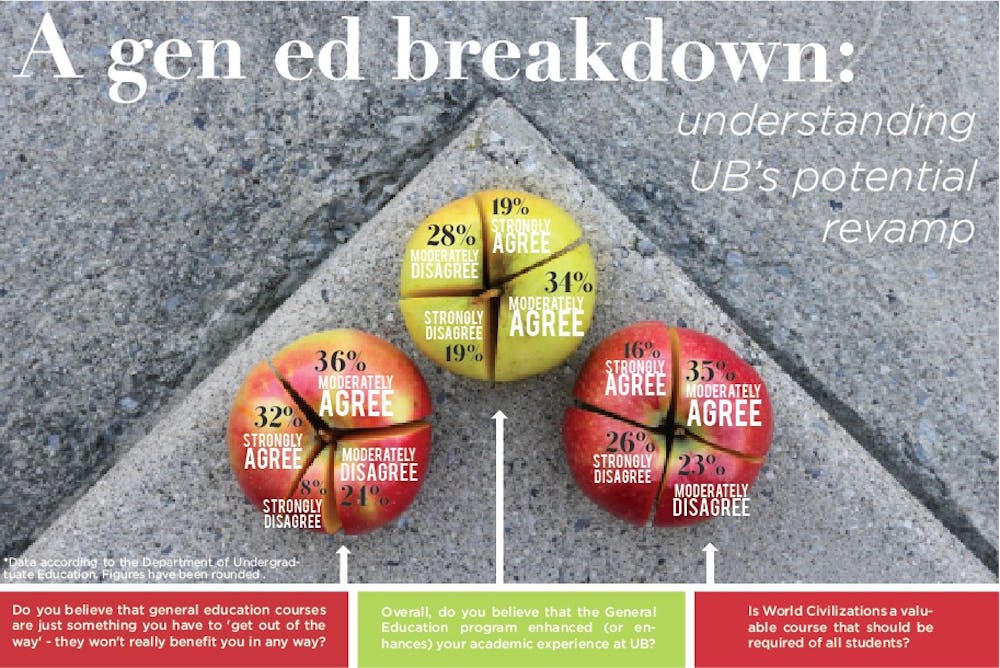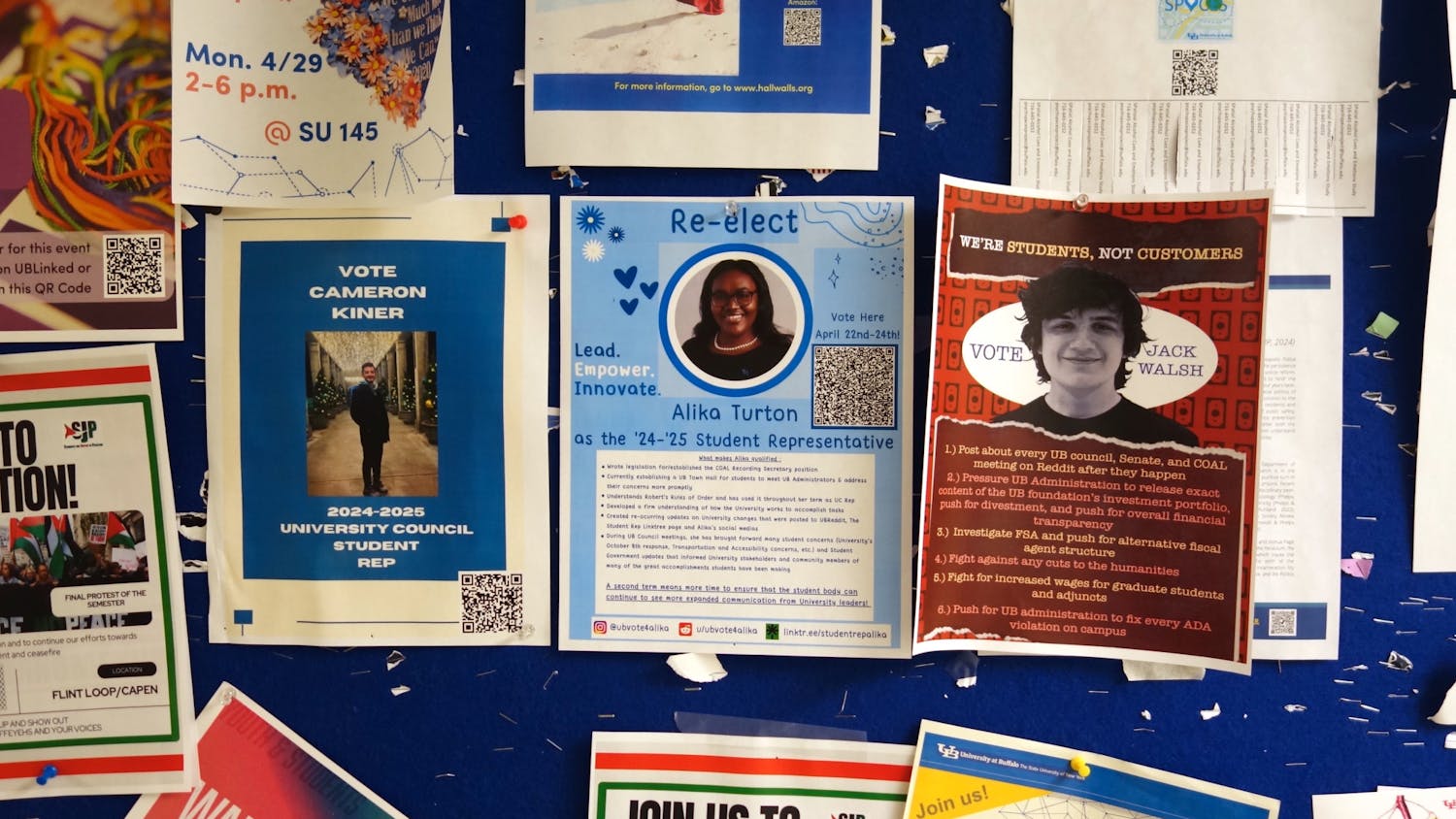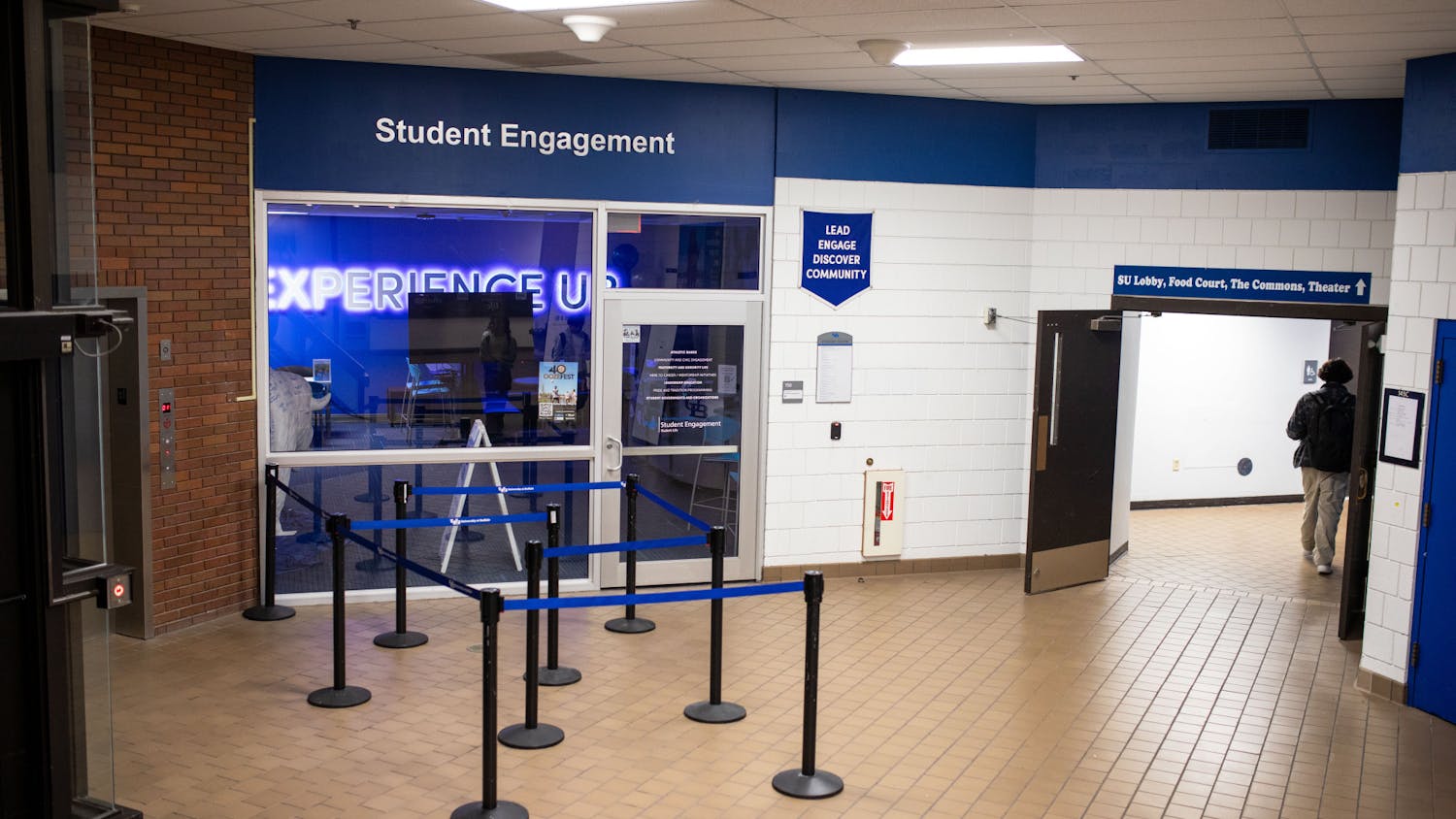By 2016, students entering UB may not be puzzled by phrases like “integrated clusters” and “e-portfolios” – the terms are the key to UB’s proposed general education overhaul.
The majority of students aren’t satisfied with UB’s current general education requirements – a UB survey showed 68 percent of students surveyed thought the required classes were just something to “get out of the way.”
On Friday, the General Education committee – which is leading the charge for a new curriculum – hosted its second open forum about the suggested new program, which emphasizes critical thinking and communication skills as well as capstone projects and studying aboard. Overall, the proposal was well received by attendees of the forum who feel an overhaul is needed.
“Our desire was to build an unapologetic, student-centered program built around high-impact educational practices to reassert UB’s commitment to the liberal arts and focus on delivering knowledge, skills and experiences that will enable our students to flourish in a diverse, dynamic and rapidly changing world,” said Andrew Stott, dean of undergraduate education.
The proposed curriculum has 35-39 credits worth of classes compared to 39-48 in the existing program. Currently, one-third of a student’s courses are general education requirements – but many students are getting exempt from certain classes like foreign language and writing skills. Stott said the current program has gradually eroded.
Provost and Executive Vice President for Academic Affairs Charles Zukoski said at Friday’s open forum he has set aside $3 million annually to invest in the program.
“That is new money on the table above and beyond what we’re already putting into general education across the campus,” he said. “It is an indication of our will – the will of the faculty – to grow this program because we think it’s so valuable to the students that we educate and call our alum once they leave us.”
Only 19.35 percent of students said they “strongly agree” that the current program “enhances” their academic experience, according to a UB survey of 3,000 students. The survey shows 35.21 percent “moderately agree” with the same statement.
The new program reinforces students’ interest by offering classes potentially related to their fields of study.
Breaking down the proposed curriculum
The program proposes a first-year seminar for freshmen and transfer students. A communication literacy sequence – that in addition to writing skills focused on oral, digital and visual presentations – will replace the current writing and composition requirement.
Students also may have to take fewer science credits than the current seven to 10 under a new scientific literacy and inquiry requirement. The proposed math and quantitative reasoning class may allow students to fulfill their math requirement with classes that could focus on things like credit card debt or personal finance, according to the proposal.
The proposed curriculum also has students complete three classes within two “clusters,” one categorized as “thematic” and the other as “global.”
Students in the future may be making decisions about what type of “cluster” track they want to take. These classes are related to each other under the same theme, which doesn’t exist in UB’s current setup.
The thematic integrative cluster will have students take three classes connected by topic – students would potentially have a choice of five topics: health, humanities, innovation, justice and environment. This cluster would take the place of the current social science and history requirements.
About 49 percent of students surveyed found World Civilizations – which currently exists as a required history sequence – not to be a valuable class.
The global integrative cluster would allow students to pick one of three tracks: a global/diversity track, in which students would have a choice of three connected classes similar to the “thematic” cluster, another that allows students to take at least nine credits of a single language or one that allows students to study abroad for six credits.
As part of the proposed general education requirements, students will have to create a digital portfolio called an “e-portfolio.” Each student will need to complete an “integrative capstone,” which uses the e-portfolio, to graduate. Students will start the portfolio, which will archive a student’s academic career, at college orientation.
Stott said he wants to promote “folio thinking,” which means thinking about “ideas, concepts, classes, content in relation to other things.”
UB community concerns
At Friday’s open forum, the e-portfolio caused a lot of questions among the present faculty, as they wondered how effectively students might use the platform.
Barbara Bono, an English professor, suggested the digital platform couldn’t replace human interaction.
“I want to suggest that the marvelous tools that we have that enhance efficiency like present-day learning platforms or the e-portfolio aren’t going to substitute for that thought and continually renewed human effort that we’re going to need,” she said.
Bono said if tools like the e-portfolio substitute for human interactive learning, students would eventually feel they are just learning from a “screen.” She said the platform would require periodic in-person meetings to be successful.
Michael Cowen, a mathematics professor, asked the panel of seven faculty members present at Friday’s forum to elaborate on how the e-portfolio will be overseen. He said he worries about how consistently the suggested digital portfolio would be used.
Stott agrees there is potential for the e-portfolio to become “another electronic sign-in” for students to “fritter it away.” He said the first-year seminar would work closely with the e-portfolio as a part of the syllabus to ensure students understand the goals of it throughout their academic career. Faculty could also use the e-portfolio as a required mode to submit assignments so students could start using it consistently, he said.
Stott said there are still some unknown elements about how exactly the e-portfolios would work, but the committee is running a pilot program of it with more than 800 students this semester.
Colleen Culleton, an assistant professor in Spanish, asked if most undergraduate students will end up finishing their general education requirements in their chosen discipline or go beyond their major.
“I’m wondering if the intention here is for students to step out of their comfort zone or if it’s to explore the breadth of one particular area on campus?” she asked at Friday’s forum.
UB is still required to follow the SUNY General Education Requirements, which provides the guidelines for every student to graduate in compliance with the State of New York, Stott said. The clusters fulfill the SUNY requirements and allow students to branch out to different departments through the various themes if they so choose.
While it may be possible to have students fulfill the clusters only within their major, Stott hopes there will not be many “incurious students.”
Walt Hakala, an English assistant professor, asked the panel for the “reason behind a one-size-fits-all approach” instead of separating the requirements for different schools.
Stott said this is for “clarity of purpose” and to create a “distinctive UB flavor” for the curriculum. This will allow all UB students to share intellectual experiences and simplify the program for students, faculty and staff, he said.
Jeri Jaeger, a professor of linguistics and former associate dean of undergraduate education, asked about the potential “massive number of new courses” that departments would have to create to fulfill the new cluster themes.
Stott said the proposal is meant to just absolve the undergraduate college courses, or UGC prefix. World Civilization classes, for example, could still be offered but under an existing department rather than be a UGC class, Stott said.
“Those very big service courses that float free of any departmental ownership has caused trouble in assessment and wide variation across the sections and some of them are not even compliant with SUNY,” Stott said.
Stacy Hubbard, an English professor, said she and others are concerned about the potential for students to avoid taking a foreign language under the “global” cluster.
“Like many people, I’m still pondering the elimination of the language requirement or the potential elimination,” she said. “I’m not sure in the context of the larger world and the university’s emphasis on global and international education, whether that’s really wise. I don’t think we should go more parochial, I think we should go the other way.”
The committee’s proposal is 117 pages long. The university has made no formal decisions on how and when the curriculum will be revamped.
Stott said the committee will take suggestions for the final proposal up until Oct. 2. The proposal will then be presented to the Faculty Senate. If the body passes the proposal by December, the soonest the new curriculum could be in place is fall of 2016.
email: news@ubspectrum.com





